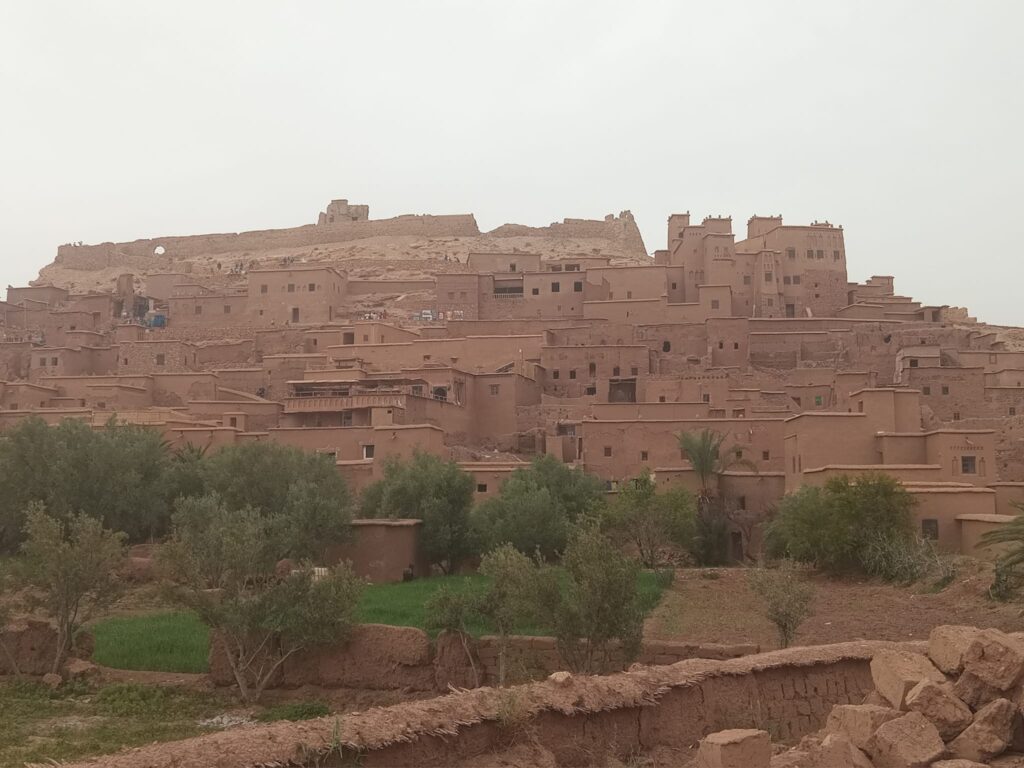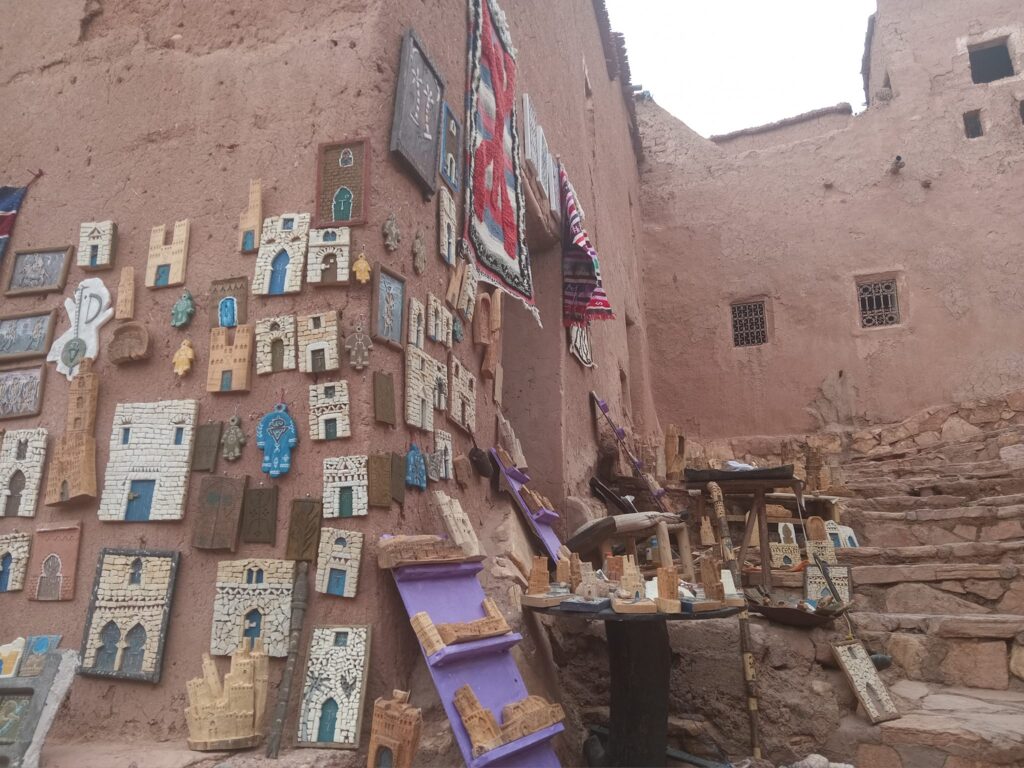I waited near the Cafe de France in the center of Jemma el-Fnaa, usually a place that is electrifying and tantalizing, but early in the morning and during Ramadan quiet except for a few fresh juice stalls. Being solo I was placed in the front squeezed in between the driver and our guide who impressively knew multiple languages, a common theme in Morocco. Half of our group was from Spain and only spoke Spanish and the other half was English speaking, and our guide switched between the 2 languages seamlessly when explaining the history of the locations we visited. We had a long drive ahead so I settled in and couldn’t help but fall asleep many times throughout.
We intertwined our way through the colorful, heavenly Atlas Mountains. The scenery was mesmerizing, and fields of wildflowers grew on the sides of the road where a few people stood by picking them and placing them in woven baskets. At a certain point the wind became a hazard, and our driver struggled holding the small bus on the road. Some parts of the road were blocked by rockslides, and we had to take an alternative route usually right next to a large mountainous cliff. We stopped for a photo op at an infamous Mission Impossible filming location and then an argan oil cooperative, where we sampled bread and the different types of argan products. Some used for beauty, others for culinary purposes. The argan tree is only produced in Morocco and so the argan is a staple of pride here.
I tried my first tagine near Ait Benhaddou. The tagine is named after the earthen pot it is cooked in and usually consists of many vegetables and a protein source. Afterwards, we explored Ait Benhaddou. It has been featured in many films such as Gladiator and Game of Thrones, but the history is what intrigued me.


Ait Benhadou is an adobe clay village with narrow alleys. A few families still reside here and at one point the village was shared between the Jews and the Muslims. Our Amazigh guide pointed out the architectural differences. The Jewish quarters had flat roofs whereas the Muslim side had more pointed towers. We viewed the oldest structure here which was on top of the mountain but had been damaged during an earthquake years prior. Ait Benhaddou was an important trading post and a major stop on the Trans Saharan trade route. Our guide explained that the people that predominantly lived here were called Imazighen.
The Imazighen people are an ethnic group who has one of the oldest languages in the world. When the Bedouins came from the Middle East bringing with them Islam, many Imazighen people eventually converted to that. He also explained that Imazighen women used to tattoo their face, particularly the chin or forehead to show if they were married and/or had children. But since Islam forbids tattoos, this practice has begun to die out.


In Ait Benhaddou, there are several artists that create art using tea staining as their technique. Another popular item sold in shops included the colorfully dyed scarves. After leaving Ait Benhaddou, we passed through Rose Valley.
Like the name suggests Rose Valley is known for its roses that bloom fully in May and fill the air with a sweet aroma. Each year the town has a festival to commemorate this event, and they choose the prettiest girl to be crowned the Queen of the festival. She is then awarded with a decent sum of money. After another hour or two of driving, we arrived at our refuge.
Second Day
On the second day, it was hard to contain my utter excitement to see the sand dunes that stretched as far as the eyes could see. But first we picked up an Amazigh guide who showed us around the Todra Gorge also known as the Grand Canyon of Morrocco. Todra Gorge is a rock climbers paradise which also means plenty of goats. We walked down to a river where the guide pointed out a spot in the midst of it that produced bubbles and stated that was where the life force of the river begins.
After checking out Todra Gorge we made it to another adobe town and went amongst the green oasis found in the middle where farmers produced alfalfa. He stated that a bug epidemic had tried to kill out the date palm tree. People were divided on the solution with some suggesting they kill the infected trees by burning their roots to prevent further contamination while others feared that the date palm would end up dying out because of how long it takes for the tree to grow back.
Upon exiting the oasis, we ended up in an ancient Jewish quarter and were taken to a carpet shop where the owner served us steaming, sweet cups of mint tea and displayed colorful well woven carpets. When we left the adobe village, we didn’t have much further to go until we hit the desert. Upon seeing the sand dunes, I fell in awe of their massive size. We were placed on nonchalant camels and headed further into the dunes. I couldn’t help but to imagine how travelers on the Trans Saharan must have felt sleeping underneath the stars with their camels for company and how small they must have felt in the grand scheme of things. But my mind also drifted off to how it would be crap to be a camel. Not only are they steadfast workers, but they aren’t too pretty. They are kinda awkward and gangly looking.
The hardest part about riding a camel is how you are going to get down. If you don’t hold on tight enough and lay back when the camel bends down, you will be flung over the front of it. We got off and headed up a large dune to sand board and watch the sunset. Suddenly a man came running to inform the camel ringleader that it was 7 p.m. and after working in the sun all day he paused and took long droughts of his water. I admired his devotion to Islam and Ramadan.


Luckily the desert was at a perfect temperature during my time here. When we reached camp, we were served more tea and showed our tent that contained a small bed and coat hanger. Restrooms were on the other side of camp. Later our dinner was served, but the highlight was when we all sat around the fire to listen to the Imazighen men play music. They each rhythmically hit the drums in tune with each other while another man played the hand cymbals. A couple of them sung and I was pulled up to dance. Afterwards, the men tried to teach several of us how to play the drums. They patiently worked with me. My favorite instrument ended up being the hand cymbals. I practiced over and over again fully focused but still failing.
When everyone headed back to their individual tents I went away from any source of light and stargazed for a bit. I love admiring the stars and here different constellations loomed overhead. The man that had taught me the cymbals found me, and we talked for a bit. He pointed to my right and said the Algerian border was very close to us. He talked about his childhood and how one of his brothers also worked at this camp. I asked him if there were any snakes or scorpions, I should be wary of, and he informed me that it was not the time of year for them. After saying our goodbyes, I decided it was time to get some rest.
Last Day

We awoke to an early start to watch the sun rise. Some chose to spend a few extra bucks to race across the dunes on ATVS, but I chose my steady camel friend. When we got off our camel we headed up to a dune where I tripped and fell on my face thanks to my scarf. A man pulled my clumsy hind end up and we all watched the art unfold before us with the bright sun that began to come up over the orange dunes. I ran down the dunes and petted my camel to give it some loving. It could have cared a less I assume. Today was our longest driving day which lasted for 9-10 hours. At one point I woke up to us hitting a dog that had ran out in front of us, but thanks to our drivers’ quick reflexes we barely tapped it and the dog ended up being okay. Upon arrival back to Marrakesh, it was a jaunt to the senses. All of the noises, smells, and people juxtaposed to where I had just come from. Now it was time to decide where I shall go next.

